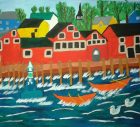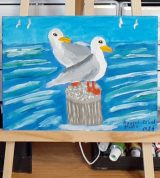Neither The Pigeons nor The Raven…
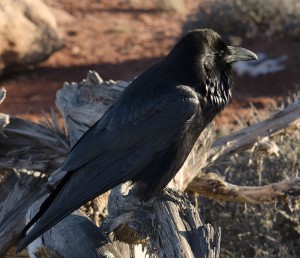
Every Human culture has its tales of the Raven.
Some, out of ignorance and inattention, fear it. But those close to the natural world, those who love the Sacred Land, revere it. The Raven is the most intelligent of all birds, and folk tales as well as scientific observation celebrate its ingenuity.
In Yellowknife, Arctic Canada, for instance, ravens have quickly learned to sit on top of street lights to cover the light sensors. This turns the lights on in daytime, warming the sitting birds. More below on their antics…
Here, with a large input from author Roland Anthony Gimeno, is a tribute to the legendary thief, trickster and “Black Thunderbolt.”
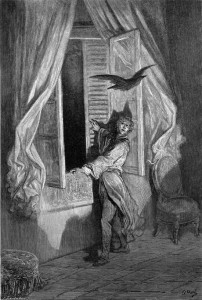
“Open here I flung the shutter, when, with many a flirt and flutter,
In there stepped a stately Raven of the saintly days of yore;
Not the least obeisance made he; not a minute stopped or stayed he;
But, with mien of lord or lady, perched above my chamber door—
Perched upon a bust of Pallas just above my chamber door—
Perched, and sat, and nothing more.” — Edgar Allan Poe [1]
“Although I do not know the answer to the Mad Hatter’s riddle posed to Alice in Lewis Carroll’s ALICE IN WONDERLAND: ‘Why is a Raven like a writing desk?’, I do know how to tell a raven from a crow!” — Grandma Pearl [2]
“The raven is big, black, and beautiful. Its highly glossed plumage shows iridescent greens, blues, and purples, shining like a black dewdrop in the light…
“And it dives and rolls like a black thunderbolt out of the sky or speeds along with liquid, gliding strokes. The raven is the paragon of the air, and more. We assume it to be the brains of the bird world, so deep, sonorous, penetrating voice demands immediate attention and respect, even though we have little or no idea what it says. It has a greater variety of calls than perhaps any other animal in the world except human beings. It’s an imposing bird.” — Bernd Heinrich [3]
What Makes the Raven Different?
WHO would expect anything from this bird with its somber colors and mournful croak?
Why, to the uninitiated, at first glance it appears to be merely an oversize crow. The raven doesn’t quickly attract attention like the blue jay, its colorful cousin with the bright blue outfit. And few would consider the raven’s croaking to be much of a song, although the bird is classified along with the passerines, or songbirds. However, don’t underestimate this bird. What it lacks in tuneful song and colorful appearance, it more than compensates for in other ways. The raven has beauty and characteristics all its own. Indeed, many bird authorities rank the raven in a class by itself.
Distinguishing Features
The common raven (Corvus corax) is by far the largest and most dignified of the entire crow family (Corvidae). It can be more than twice the weight of a common crow and measures about two feet [0.6 m] in length, with a wingspan of some three feet [1 m]. It differs from the crow in that it has a heavier bill and a long, wedge shaped tail. Closer observation also reveals the ravens identifying shaggy throat feathers. In flight, it is famous for soaring, while crows tend to flap and glide.
The raven is ranked as the largest of all perching birds. Observing this large bird crouched on a limb resting, you would wonder how it keeps from falling off its perch. At the back of each foot is a strong claw for grasping a branch or a twig; however, the secret to hanging on is a built-in locking device. Muscles and tendons automatically pull the toes into a fist when the bird crouches. The raven’s strong, all-purpose feet are also suited for walking and scratching, thus equipping it well for gathering food from a wide variety of feeding grounds.
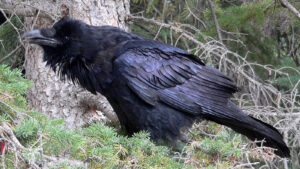
Range and Flight of the Black Thunderbolt
Very few birds have as wide a range as the raven. They are roamers. It can be found in many parts of the Northern Hemisphere. It lives in such dissimilar terrain as desert areas; the coniferous forests of Canada and Siberia, where it makes a complex nest of sticks and other available material in high trees; the cliffs of the sea in North America and Scandinavia; and the tundra and islands of the Arctic Ocean. Wilderness appears to be the one common denominator of its range, for the raven is usually a bird of the wilderness.
Examples of its diverse habitats can be found in the land of the Bible, where two varieties of the great black raven live. One makes its home in the wide expanses of desert in the south, while the other inhabits the northern region. Black ravens nest among the nooks and crannies in the rocks along ravines. Ravens were used by Jehovah to feed Elijah while he concealed himself in the torrent valley of Cherith. (1Kings 17:3-6) Isaiah’s account of the ravens inhabiting the emptiness and the stones of the waste of Edom is also descriptive of their habitat.
Ravens are wonderful fliers.
They’re beautiful to watch as they soar effortlessly in wide circles, scanning the area below for food. They perform aerial acrobatics with ease — somersaulting and even briefly flying upside down — particularly during courtship and, it would seem, sometimes for mere pleasure.
The raven’s flight is aptly described by Bernd Heinrich in Ravens in Winter: It dives and rolls like a black thunderbolt out of the sky or speeds along with liquid, gliding strokes. He adds that it is the paragon of the air, and more. The raven’s strength of flight has been given as a reason why Noah chose it as the first creature to be sent outside the ark at the time of the Flood..
Adaptable and Resourceful Thieves
Naturalists regard the raven as one of the most adaptable and resourceful of all birds. As one source says, its cunning is legendary. Whatever circumstances the raven encounters, it proves equal to the challenge of adapting to existing conditions, especially in regard to food.
Of course, not being a finicky eater helps! The raven will eat almost anything it can get its claws on — fruits, seeds, nuts, fish, carrion, small animals, refuse. Ravenous appetite? Perhaps. And it is not fussy about where it finds its food, even resorting to digging beneath snow to raid garbage bags during subzero weather in the northern parts of its range. Ravens will also follow hunters and fishermen for days, somehow sensing that there will be food for them in time.
The Corvidae, or members of the crow family, are notorious thieves, and ravens are no exception.
They are not averse to stealing food from other birds or animals and have been observed playing tricks on dogs. A pair will take turns — one distracting the dog while the other swoops in to take its food. Inuit art depicts a crafty raven stealing fish from an ice fisherman.
Ravens have a special rapport with wolves, routinely following wolf packs. They dine on the wolf kill, but here again, they seem to enjoy some humorous antics while doing so.
Wolf biologist L. David Mech records seeing ravens playing pranks on wolves. He tells the story of one raven that waddled to a resting wolf, pecked its tail, and then jumped aside when the wolf snapped at it. When the wolf stalked the raven, the bird would let it come within a foot of him before rising. Then it would land a few feet beyond the wolf and repeat the prank. Another account tells of a raven playing tag with wolf pups. When the pups tired of the game, the raven sat squawking until they resumed play.
In earlier times, ravens interacted more with ancient humans.
They followed hunting parties, knowing there would soon be meat to share. In fact, they often flew ahead of hunters, dipping their wings when they spotted prey, signalling the eager hunters.
Since prey is prey, they used the same tactics with war parties. Thus the Raven (and the wolf) featured large in Northern European warrior cultures, often represented on shields and battle flags, as well as tribal names. After a bloody battle, the ravens feasted.
Canadian Geographic magazine refers to a CBC radio broadcast from Yellowknife, Northwest Territories, that told of ravens perching on sloped metal roofs of commercial buildings, apparently waiting for unsuspecting pedestrians to pass below so they could send the accumulated snow sliding down upon them. No wonder the Haida people of Canada’s west coast call the raven a trickster!
— Roland Anthony Gimeno lives in the Philippines. His wonderful website The-Ostrich-And-The-Stork.blogspot isn’t currently active, but as of this writing Roland can be found on Facebook.
— Brian Alan Burhoe is the author of many fiction and non-fiction works dealing with wildlife. His first published work was the short story “Ornithanthopus.”
Learn More! See This: WHO IS NANTOSUELTA? Celtic Woman, Home Goddess & Raven Keeper
[1] Poe’s narrative poem “The Raven” became his most popular poetic work. It appeared originally in January, 1845, in the New York Evening Mirror, and is still being reprinted. The illustration shown above was by Gustave Doré.
[2] “So how do you tell them apart? There are several ways. The flight pattern is different, for one thing. You’ve heard the phrase straight as the crow flies? Well that definitely applies to crows. But ravens like to soar and fly in meandering circles, like hawks. They are very acrobatic, and often tumble while in flight, just for fun!
“Another difference: ravens are the equivalent of crows on steroids! Ravens measure 21 to 27 inches from beak to tail. A crow is only 17 to 21 inches in size. A raven’s neck and upper body is thicker and beefier than a crow. And the throat feathers of a raven appear shaggy because of the long feather shanks in the neck area. The beak of a raven is heavier and larger, too. A crow’s tail has a fan shape that is particularly evident in flight. A raven’s tail has more of a wedge shape, and is more squarish.”
See Grandma Pearl’s Make an Edible Christmas Tree for the Birds
[3] A favourite book of mine is Bernd Heinrich’s MIND OF THE RAVEN, a wonderful introduction to his studies of the bird, especially in Maine. Other beloved titles by Mr Heinrich are THE TREES IN MY FOREST, RAVENS IN WINTER and A YEAR IN THE MAINE WOODS. To see more about his books, go to Naturalist’s Notebook – A Complete Guide to Bernd Heinrich’s Books





